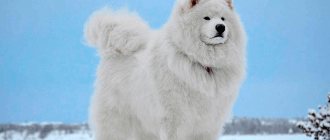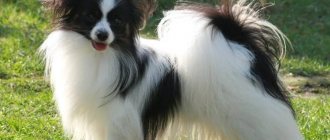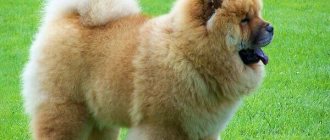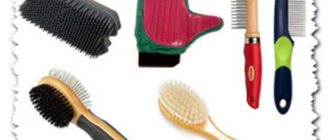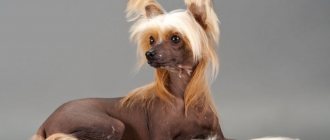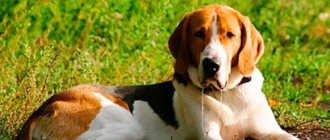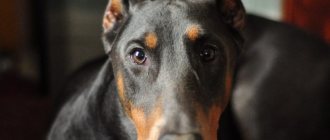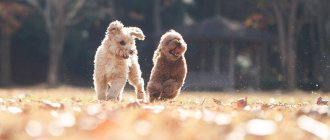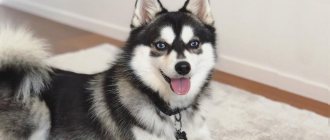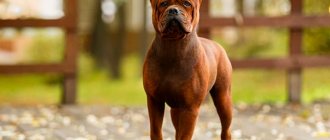The Australian Labradoodle is a unique “designer” breed of dog. It was specially developed in the middle of the last century, and we can definitely say that work on it is not finished yet.
Another name for these dogs is labropoodle, but neither the first nor the second is officially registered. The breed was created by crossing a Labrador and a poodle; it was invented with the goal of creating a companion with a soft, good-natured character and hypoallergenic coat. The Labradoodle turned out to be a real family pet, a sociable guy. It can serve as a guide dog, but is completely useless as a guard.
Photo: pixabay.com
Description and features
The appearance of a Labradoodle depends on what species it is. More details about the varieties will be discussed below. The height of an individual can be between 30-60 cm. Weight is from 10 to 40 kg.
The main characteristics of the appearance of a Labradoodle include:
- Muscular physique.
- The legs are strong and the paws look like a cat's.
- Smooth back and toned abdominal cavity.
- Low straight tail that is not docked.
- Large, slightly wide muzzle. It has a square shape.
- Expressive eyes of a dark color.
- The ears are at eye level. They are hanging.
Little fluffy dogs
Miniature breeds are ideal for apartment living; moreover, most small long-haired dogs will not be able to survive on the street . They need careful care, moderate exercise, and a warm and dry place. When choosing such a puppy, future owners must understand that they are taking a new small child into the house.
Red fluffy – Spitz
Now it is one of the most popular breeds. Small, restless, loud – bundles of energy and positivity. Spitz dogs look like red foxes. They have an elongated muzzle, a compact body, short legs and thick fluffy hair that makes the dogs look like balls. Dogs are 20-30 cm at the withers and weigh up to 3.5 kg . Color – red, sand, wheat.
A German breed bred specifically to be companions for farmers. Their ancestors are the great northern Laikas, so their little friends are distinguished by their courage, determination, and willfulness.
Papillon
A miniature apartment dog of French origin with a name literally translated as “butterfly”. Papillons' ears are set high and wide, and the hair falls like a waterfall so that the silhouette resembles the wings of butterflies. The second variety of the breed is Fallen, the animals are no different except for the placement of the ears - in the Fallen they are lowered.
This breed ranks among the top ten smartest dogs. Indeed, Papillons are very cunning; not all owners will be able to tame their temper. To avoid open manipulation on the part of the pet, it needs to be raised for a long time.
In temperate climates, the breed sheds twice - in the off-season. But with any weather changes or immune problems, dogs actively shed their hair, leaving a trail of blond hair everywhere.
Tibetan Spaniel
Dogs with a complicated history. The name speaks of their geographical homeland - the eastern Tibetan mountains . According to legend, the animals helped guard the temples of the monks and gave vocal signals when enemies or guests approached, which were then dealt with by large Tibetan mastiffs. The second part of the name is a clear reference to European hunting spaniels.
For this reason, the dogs have absorbed the features of Japanese Chins, Pekingese and aristocratic English pets. They are small in size (up to 25 cm), with a wide loin, strong bones, and a fluffy fountain tail . The breed has a fluffy coat of predominantly red colors, but others are allowed; Tibetans shed 2 times a year.
Coton de Tulear
Having first met this aristocratic breed, a representative of lapdogs, it is difficult to imagine that Cotons once lived in the holds of ships, hunted rats and were known as good sailors. Dogs appeared in Madagascar from the mixing of European lapdogs with aboriginal dogs.
A pleasant feature is the long soft coat and lack of shedding. Therefore, the breed is considered hypoallergenic. But the property of hair is constant growth. Therefore, animals need periodic haircuts, constant combing and frequent bathing.
The dogs' height is 25-28 cm, weight is 5-6 kg. The correct color is white, but there are individuals with lemon fur, dark brown spots or a black coat. The name suggests that the hair of the breed is “cotton” - coton - cotton.
Chihuahua (longhair)
The breed appeared in Mexico during the times of the Mayan and Aztec tribes, when animals served as guides of souls to the afterlife. They were loved and worshiped until the colonialists came and exterminated almost the entire Chikhov population . The kids ran into the forest, learned to hide from people and defend themselves. But at the beginning of the 20th century, residents of Mexico found them and started selling puppies to America. After which cute little dogs conquered the world with their cuteness.
Chihuahuas are the smallest among all breeds, growing no more than 23 cm, weighing 1-3 kg. There is even a separate subspecies - cap, from the English cup - cup. That is, doggies that fit in a teacup. In general, the breed is short-haired, but over the years of aboriginal life, fluffy long-haired Chikhas with soft silky feathers on the ears and paws appeared.
Distinctive features are a strong, squat body, an apple-shaped head, sharp, large erect ears and bulging eyes. They can be any color, variegated apricot or silver-beige, black and tan.
Such pets are complex in character, self-sufficient, strong, but timid and often embittered. They are emotionally attached to their owner and do not like strangers.
Pekingese
An oriental dog, originally from the Celestial Empire. From time immemorial it served the imperial family and was considered practically sacred and untouchable. It was impossible for ordinary people to own Pekingese; only nobles could receive a puppy as a gift from the emperor. The animals slept on feather beds, played with the children, and enjoyed the benefits of palace life.
That's why dogs are now considered a little arrogant. They are jealous of their belongings and owners, do not like strangers, but are always ready to bask in the glory and show their best side.
Externally, Pekingese are stocky (up to 20 cm at the withers), with a wide back, short legs, and a fluffy tail thrown over the back. Dogs have fluffy fringes on their ears and paws. The muzzle is flattened, the eyes are large and protruding. They can be any color, the pets are bright, which is why they have gained popularity all over the world.
Bichon
The fluffiest and most unusual lap dogs are the Bichon Frize. Their fur is dense curls that form a ball silhouette around the head and body. Pets are very smart and active, so they often take part in circus performances and show programs. The dogs are friendly, love children and other animals.
Breed height – 23-20 cm, weight – up to 5 kg. Bichons have good strong muscles, making them good at obstacle courses and dog sports. But the cover requires a lot of time and effort. Their white curls don't just need brushing. After each walk, it is important to pick out all small debris, wipe your eyes from tears, wash your paws and cut off any overgrown hair between your toes. Regular grooming will help with care.
Havanese Bichon (Havanese)
This is a small aristocratic dog originally from Cuba. Has a friendly and affectionate character. Height does not exceed 30 cm, weight up to 3.5 kg. The Havanese's coat is soft, dense and lush. The color is white, spotted, various shades of dark or brown are possible. It is not allowed to artificially change the appearance of the Bichon's coat by trimming or cutting. The cost of such a dog ranges from 30-45,000 rubles.
Kinds
There are several types of these hybrid dogs, which are presented in the pictures:
Type F1. This species has an equal set of poodle and labrador genes. The physical characteristics of the individual are from a Labrador, and the coat is from a Poodle.
Type F2b. This species is characterized by ¼ of the genes from the Labrador and ¾ from the Poodle. Visually, mestizos resemble poodles. However, they have the character and skills of a Labrador. The only difference is the lack of instinct to hunt.
Miniature Labradoodle. The height of a mini Labradoodle is about 40 cm.
Medium labradoodle. Height is about half a meter.
Standard. Height is about 0.5-0.6 cm.
History of the breed
Experienced breeders from Australia worked on the development of this dog breed. The Australian Labradoodle became famous in the 80s of the last century.
This happened after a famous Australian breeder crossed a Standard Poodle and a Labrador Retriever.
The first Australian Cobberdog, nicknamed Sultan, had no fur, which did not provoke allergies. However, the Australian Poodle had fairly developed intellectual abilities, so it could be used as a guide dog. When other breeders decided to acquire such a popular breed, they began to call it “doodle”.
Briefly about the main thing
- The Labradoodle is a designer breed created by mixing two other breeds;
- The officially registered breed standard is the Australian Cobberdog;
- The dogs are friendly, sociable, obedient, recommended for families with children and novice dog breeders;
- According to the standard, Labradoodle fur does not cause allergies, but due to confusion with breeding it is difficult to guarantee this. It is necessary to take puppies only from official nurseries, then the dog will not shed;
- Gets along well with people and other animals, loves to play and does not show aggression without reason (if a dog is scared or hit, the consequences are always difficult to predict);
- Two walks a day are necessary, one of them for at least an hour in the fresh air. Active exercises are needed outdoors, maybe running next to a bicycle;
- The coat needs regular brushing;
- In general, the Labradoodle is a good, undemanding dog. It serves excellently in social terms, is used in searching for missing people, in rescue work, as a guide dog.
Character
If you train an animal correctly, it can settle well into a family. Labradoodles have a friendly nature. She will behave tenderly in the family and devote herself entirely to people. However, character can change depending on certain factors. It all depends on heredity, and how much people will engage in education.
If raised correctly, the Labradoodle dog will be curious and playful. If necessary, they will always come up to a person and help him. When choosing a pet, check with the puppy's parents to make sure it has good heredity.
It is important that the puppy lives in a social world. Therefore, from a young age he needs to be accustomed to people. It is advisable to accustom him to different places and sounds.
Nutrition
There are no specific dietary recommendations for Labradoodles. They need to be fed a balanced diet. It is not difficult to find it in pet stores. Give preference to premium dog food. Holistic food, which is made from natural ingredients, has proven itself well. Sometimes an allergic reaction to certain foods may occur, so you should consult your veterinarian first.
To use natural food to feed a dog, the diet must contain the following components:
- Squirrels. You can feed your pet lean meat, fish and cottage cheese.
- Cellulose. Labradoodles love vegetables, fruits and greens. If you give vegetables, they should be fresh or boiled.
- Carbohydrates. Introduce durum wheat pasta into your animal's diet.
- Cereals. It could be buckwheat, rice or millet.
In addition to regular food, buy a complex of vitamins and mineral components. Consider the ratio of components. A Poodle Labrador mix's diet should contain at least 80% protein.
Feeding
The Labradoodle's diet is typical for dogs of a similar constitution. With a more active lifestyle, it is worth increasing the portion size; if the dog sleeps a lot at home, reduce and shift the ratio of ingredients towards cereals, vegetables, and balanced dry food. The basis of nutrition is lamb and beef, poultry (chicken and turkey), fermented milk products, cereals and vegetables. Eggs are sometimes allowed, and special vitamin and mineral supplements are recommended.
Bones, especially from poultry, are contraindicated for dogs; sinews and special artificial “bones” purchased at a pet store are suitable for cleaning teeth. Puppies eat up to 6 times a day, they especially need cottage cheese, fish is allowed once a week, one egg. Get a veterinarian's recommendation on which dietary supplements are suitable for babies under one year old. An adult dog eats twice a day.
Photo: pixabay.com
How long do they live
Many kennels breed such dogs. And they do not always have experience in this area. First generation puppies may surprise you with their behavior, as it will be quite difficult to predict it. They are able to take qualities from their ancestors in a chaotic manner. It is better not to crossbreed hybrid breeds, because over the course of a generation the puppies will lose their original qualities. Over time, they may lose health.
There is always a risk of getting substandard dogs. This is due to the fact that puppies cannot always pick up hypoallergenic indicators from their parents. Some individuals may turn very blue. If you cross two Cobberdogs, the puppies will be predictable.
Large labradoodles live slightly shorter lives than smaller ones. Their age, with proper care, is about 14 years. Small dogs can live up to 17 years.
Alaskan Malamute
Nature has endowed Malamutes with remarkable intelligence and intelligence. Just look into their eyes, the expression of which differs little from human ones. But it is precisely the sharp mind, combined with an independent character, that makes the training process very difficult. Malamutes are leaders by nature, and the owner will have to make a lot of effort to cope with the pet.
The temperament and performance of the Malamute can only be envied. They can carry loads 24 hours a day without seeming tired at all. The owner’s task is to provide the Malamute with these loads, otherwise the energy will go in the wrong direction, and the dog will cause a real pogrom in your home or yard.
Malamutes love to dig. And they do this all the time, even while in the apartment. On the site, he is quite capable of digging under the fence and escaping. But they won’t sit on a chain either. Like any fluffy dog , Malamutes are not adapted to normal life in countries with hot climates. They prefer the north with its endless snow, through which they can drag sleighs with loads.
Care
The Labropoodle is unpretentious. He can live not only in private houses, but also in city apartments. Dogs do not cause trouble to their owner.
Basic rules for care and maintenance include:
- Brush your pet regularly.
- Wipe the wool with a damp cloth. This will prevent the formation of dirt and dust.
- Trim excess hair every month. Especially in the area under the ears and around the eyes. To keep your pet clean longer, trim the hair in the intimate area.
- Clean your eyes, ears and teeth. This needs to be done every week.
- Take your pet outside for a walk every day. The Labradoodle needs vigorous play and exercise.
Irish Setter
A very sociable dog that does not want and cannot tolerate loneliness. The charming appearance of an aristocrat, infinitely intelligent eyes and the almost complete absence of smell - all these qualities are very fond of breeders. The setter sheds extremely rarely and sparingly; the undercoat does not fly around the apartment and does not remain on clothes or furniture upholstery.
But the setter's coat requires the most careful care with special washing products, daily combing and, in some cases, professional grooming. If you don’t do any of this, you will soon discover quite a lot of tangles, a loss of shine and the overall aesthetic appeal of the dog.
Initially, the Irish Setter was a hunting dog, but now it is more often seen as a companion dog, a family friend. But there is no escape from instincts. If a setter sees a pond, he will forget about everything and dive there in 9 cases out of 10.
Representatives of the breed have more than enough energy, so walks should be very prolonged in time and contain as many activities as possible. A red fluffy dog will quickly become your personal antidepressant. It’s hard to be depressed for long when you’re around a cheerful setter!
Training and education
Even though Labradoodles are very smart, owners still need to train them. Start training your puppy from a young age, as adults are more difficult to train. Training should be gradual so that the animal gets used to it. This will make the dog not only obedient. This way you will teach her to predict the desires of her owner.
Before you start training, remember that these dogs do not tolerate aggression and rudeness . You should not use force or cruelty on them, as this can weaken their immune system. This also causes the pet to become withdrawn and irritable.
For each completed command, reward the dog with something tasty. This will make the training process more effective.
The best names for Labradoodles
When choosing nicknames for pets, it is advisable to follow some rules. Of course, a purebred puppy often has a complex nickname assigned to him in the kennel, but at home the owner usually comes up with something of his own.
The nickname should be sonorous and short, so that it is easier for the dog to remember and convenient for the owner to pronounce.
Nicknames for boys Labradoodles:
- Jim;
- Rex;
- Jack;
- Edwin;
- Ricky;
- Richie;
- Cooper;
- Hector.
Nicknames for girls:
- Norm;
- Germa;
- Gina;
- Linda;
- Nika;
- Laura;
- Lassie.
Possible diseases
Today, Labradoodles are resistant to diseases such as obesity, hearing loss and cataracts.
However, they may exhibit the following diseases:
- Joint dysplasia in the pelvic area. From a young age you need to have your pet x-rayed to prevent the development of this disease.
- Eye diseases. Animals may experience retinal atrophy, which often causes blindness. Retinal dysplasia is common in British species.
- Addison's disease, which refers to endocrine diseases. It is associated with adrenal insufficiency. This disease most often occurs in Australian dogs. To prevent illness, take your pet to the veterinarian regularly for blood sugar, urine, and blood tests.
House or apartment?
Living conditions for Goldendoodle pets do not play a big role. But, it is worth considering that activity and energy in “cramped circumstances” can bring undesirable consequences, such as damaged wallpaper, furniture, interior items and personal belongings of household members. Living in a small apartment, the pet must be given enough time for walking and active play outside the home.
Did you know? A dog can find the source of a sound in 0.1 milliseconds.
As for dogs of decorative sizes, the conditions of a small apartment are quite suitable, but the need for an outburst of energy in the open air remains at the same level as in standard-sized breeds. For large dogs, the best option for living is a house with free range.
Price
For an Australian Labradoodle you will have to pay about $1,100. Purchasing a first generation mixed breed will cost $900.
Buying a puppy abroad will be cheaper. You will need to pay around $400-$550. Even taking into account transportation, the cost will be much lower than in our country.
As you can see, Labradoodles, with proper care, can become true human friends. If there are children in the family, dogs will be friends with them and protect them. To sum it up, these dogs are not only beautiful, but also smart. Therefore, you can safely get a labradoodle.
Afghan Hound
When answering the question, what breeds of dogs are fluffy , it’s hard not to remember the very long-haired Afghan hound. Initially, the breed was bred as a herding and hunting dog, but in the modern world it is increasingly being given the role of a pet and companion dog.
Greyhounds are vulnerable and sensitive natures. Once they have a beloved owner, they may become jealous of both other pets and family members. Seeking attention through obedience and exemplary behavior is not at all in the spirit of greyhounds; most likely in such a situation the dog will begin to play dirty tricks. Afghans are very difficult to train. Stubbornness and an endless desire to become independent get in the way.
If you decide to bring home such a beauty with a long, shiny coat, then you will have to master coursing. Coursing is long-distance running with a pet. Ready? It would also be useful to teach how to groom dogs.
This is so as not to shell out a tidy sum every 2-3 months for a dog beauty salon. The coat of greyhounds requires not just careful, but very thorough and, preferably, professional care.
